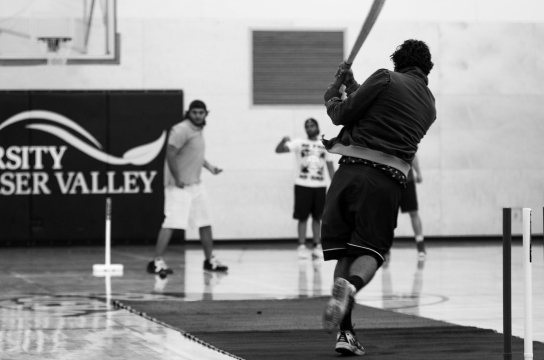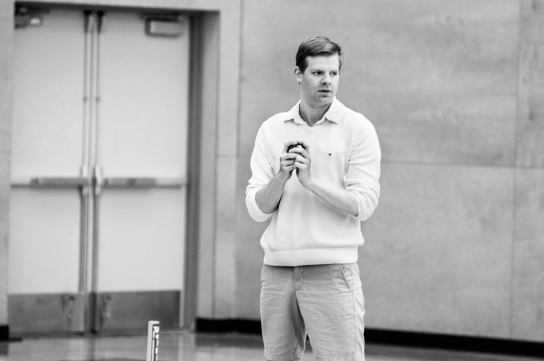By Paul Esau (The Cascade) – Email
Print Edition: October 3, 2012

Douglas Adams writes of cricket in Life the Universe and Everything that “of all the races in the Galaxy, only the English could possibly revive the memory of the most horrific wars ever to sunder the universe and transform it into what I’m afraid is generally regarded as an incomprehensibly dull and pointless game.”
While I agree with Mr. Adams on most of life’s complexities, the sport of cricket is something I think he got completely wrong.
Neither incomprehensibly dull nor tedious, cricket is what baseball should have been. No bases, less steroids, more chaos, and wickets! WICKETS! What sport, after all, wouldn’t be improved by the inclusion of wickets? In what other sport can you comment that one must “protect his wicket from the ferocious attention of a half-toss fast bowler?”
When I discovered that UFV had a functioning Cricket Club—indeed had possessed such a club since 2009—I was almost delirious with joy. I immediately called up Ahmed Iqbal, founder of the club and former captain of the team. “Ahmed,” I said, “my colleagues and I wish to learn to play cricket. We wish to learn to preserve our wickets and avoid being stumped. Ahmed, can you make this happen?”
Being the fly guy that he is, Ahmed was happy to help, and a week later he and a large part of his team met with myself and several other pasty journalist types in the UFV gym for a crash course in cricketology. Ten guys, a bat, a ball and a couple of wickets. All we were missing was a stuffed tiger and a bandit mask.
 The nice thing about cricket is that, unlike in baseball, there are no troublesome strikes, walks or foul balls. As long as the batter stays within his or her crease and prevents his wicket from being knocked over he stays at bat. Also, he or she is spared the tedious expectation of always hitting the ball forward. The cricket pitch is an oval that completely encloses the batter, so one may hit the ball forward sideways, up, down, or even orchestrate a clever backwards deflection to bean the wicketkeeper.
The nice thing about cricket is that, unlike in baseball, there are no troublesome strikes, walks or foul balls. As long as the batter stays within his or her crease and prevents his wicket from being knocked over he stays at bat. Also, he or she is spared the tedious expectation of always hitting the ball forward. The cricket pitch is an oval that completely encloses the batter, so one may hit the ball forward sideways, up, down, or even orchestrate a clever backwards deflection to bean the wicketkeeper.
Once the ball is struck the batter can choose to run or to not run based upon the quality of the hit. But if he or she does choose to run to the other wicket to score a run (and this is the true insanity of cricket) a second runner must run from the other wicket back to the original wicket at the same time. If one runner’s wicket is struck while he is not in his crease, or by some curious chance both runners end up at the same wicket, then one of them is “run out” and he or she is impaled upon the violated wicket.
I may have made up that last bit.
Anyway, the UFV Club plays a variation of “One Day Cricket” (as opposed to “test cricket” which can last up to five days)* in which each side bats only once for a set number of “overs” or sets of six “bowls” (pitches). The side which scores more runs during their one inning batting advances to the nearest bar to celebrate, while the other side retreats to the second-nearest bar to drown their sorrow. Players are only allowed to pitch a set number of ‘overs’ to prevent the kind of specialization present in baseball,** and most matches played by UFV cricket are of the 50 “over” variation. These take about five hours.
For myself—and most of the other Cascaders—it was a victory simply to hit the ball. We played several 10 “over” games with our instructors, and learned quickly that were outclassed, outmatched and outgunned. Team captain Hamsa Razzak was especially impressive (he bowls like Chris Hemsworth hurling Mjölnir at a hapless ice giant), but the whole team easily made the rest of us look foolish. Not surprisingly, the strongest member of The Cascade’s staff was “Lord” Alexei Summers, whose aristocratic English heritage led him to a surprising 10 runs off of just three pitches.
In another devious twist of fate, cricket is played with a five and a half ounce cork ball bound in leather, which is both notoriously hard and expensive.*** To compound the indignity of the ball itself, fielding is traditionally a bare-handed activity. While the UFV team does wear gloves while fielding, they’re hardly the padded leather monstrosities worn by baseballers (and they have the crooked fingers to prove it).
But oh the joy of cricket! Of catching, of hitting, or running, and of preserving one’s wicket! This is a sport to cherish both for its implicit British humour and for the necessitated skill. Keep on bowling Ahmed, Hamsa and team! UFV would not be the same without you!
*Not a joke.
**As you might have noticed by now, I hate baseball.
***We used the indoor alternative, a tennis ball bound in hockey tape, so none of us future Hemingways would bash our craniums in.



